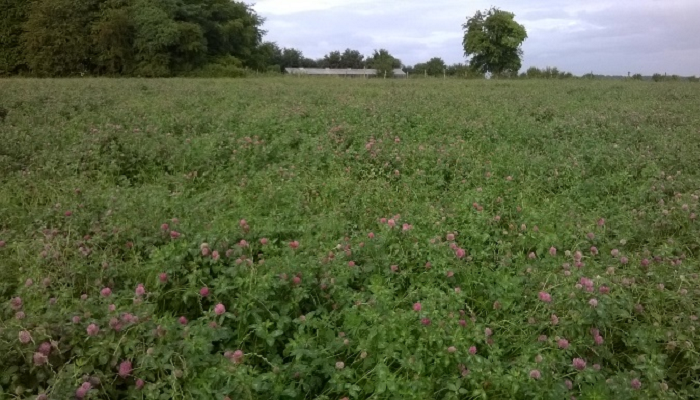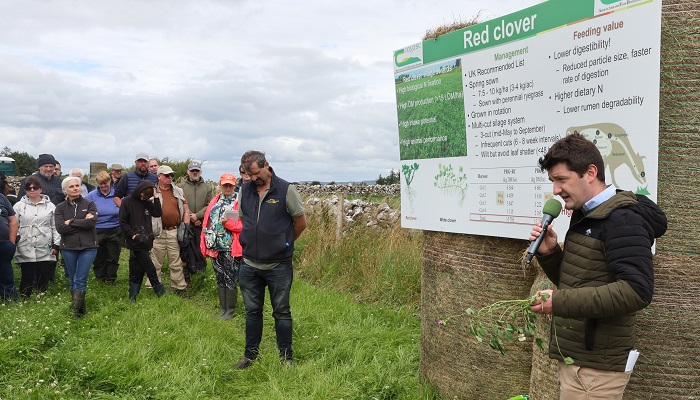21 July 2023
High levels of herbage production and animal performance from red clover

Red clover can contribute substantially to organic, low-input and conventional animal production systems due to its ability to fix atmospheric nitrogen (N) and support of high animal performance.
Dr. Nicky Byrne, Research Officer in Teagasc Grange, explained that these benefits contribute to beef systems of improved farm gate nitrogen (N) balance, through a lessened need for fertiliser and feed, while maintaining high animal performance, at the recent Growing Organics Farm Walk on Oliver and Anna Dixon’s farm in Claremorris, Co. Mayo.
Swards with a high content of red clover (75% on a dry matter basis) are capable of fixing 24-36kg N/t dry matter (DM) produced, meaning swards of high clover proportion and DM production are potentially fixing in excess of 200kg N/ha annually.
The inclusion of red clover in conserved grass silage swards can increase average daily live weight gain (ADG) compared to grass silage diets. Despite the many benefits of red inclusion, it has had limited uptake across Irish production systems, likely due to its more complex management requirements, unsuitability to frequent grazing, reduced DM yield stability and persistence giving a short term lifespan of approximately 3-4 years.
Agronomy
Unlike for perennial ryegrass and white clover varieties, no Recommended List currently exists for red clover varieties in Ireland, with Irish producers relying on information from the UK Recommended/National List to identify suitable varieties.
Red clover should be grown in rotation, allowing for a four year break to control diseases such as stem eelworm and Sclerotinia fungus (clover rot). Typically 7.5-10kg/ha of red clover in addition to 20-22kg/ha of perennial ryegrass should be sown on well drained soils with a soil pH of 6.5 to 7. Spring reseeds offer the greatest window of opportunity to optimise pre and post-sowing management.

Dr Nicky Byrne discussing red clover agronomy at the Growing Organics Farm Walk
Red clover has a deep taproot, an erect growth habit, with a low density of large shoots. Stems are formed from the growing points located on the crown on top of the taproot. Reserves of carbohydrates and N are stored in the crown and taproot, where they are remobilised to fuel regrowth after defoliation.
The crown/growing point of red clover is solitary and exposed, making it vulnerable to physical damage by machinery and animals. This means that red clover is best suited to infrequent silage cuts rather than regular grazing. Cutting intervals of 6-8 weeks allow sufficient time for the canopy to intercept sunlight to replenish energy reserves.
Increasing the defoliation frequency beyond three cuts can reduce yield due to insufficient replenishment of plant reserves and thus persistence. ‘Late’ silage harvests (beyond mid-September) can be difficult to ensile (insufficient wilting) and are of relatively low yield, making it difficult to justify economically.
To protect the crown of red clover, cutting height should be 7–8cm. Red clover has a low water soluble carbohydrate concertation and high buffering capacity, reducing its ensilability. The inclusion of perennial ryegrass as a companion species will improve the overall ensilability of red clover silages as well as wilting (24-48 hours) to increase DM concentration, while ensuring that the leaf is not damaged (shattered) as a result of over wilting and excessive machinery passes.
Red clover swards have the ability to fix high levels of atmospheric N, making it available to plants in the soil, supplying in excess of 200kg N/ha annually. Mixed red clover and perennial ryegrass swards receiving no chemical N were found to have similar annual DM production to perennial ryegrass swards receiving up to 412kg N/ha per year (15.8 and 15.7t DM/ha, respectively).
Feeding value
Cattle consuming silages containing red clover have increase dry matter intake (DMI) compared to grass silage. From this additional DMI and increased levels of rumen undegraded protein, cattle consuming red clover silage can achieve increased levels of live weight gain (ADG).
Unsupplemented (no concentrates) weanling steers offered red clover silage had a greater live weight gain (0.89 vs. 0.59 kg/day), than those offered grass silage of comparable digestibility, which was attributed to the higher intake of RC silage (7.75 vs. 5.59 kg DM/day) (Steen and McIlmoyle, 1982).
The feeding value of red clover silage appears lower than that of grass, with lower levels of digestibility because of high fibre levels, needed to support plant structure. Despite overall lower digestibility, increased DMI and animal performance can be achieved due to the faster rate of digestion of plant fibres and increased particle break down, contributing to increased passage rate and lower rumen fill.
Conclusions
The inclusion of red clover into silage swards has great potential across Irish pasture-based production systems of all intensities. These swards have an enhanced ability over grass-only swards to maintain high levels of herbage production and animal performance in the absence of chemical N fertiliser.
This article first appeared in the booklet from the Growing Organics walk on Oliver and Anna Dixon’s farm. Access the booklet here. For more information on organics, click here.
